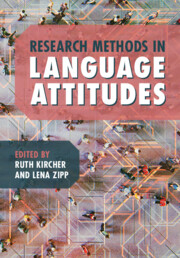Book contents
- Research Methods in Language Attitudes
- Research Methods in Language Attitudes
- Copyright page
- Contents
- Figures
- Tables
- Contributors
- Foreword
- Acknowledgements
- 1 An Introduction to Language Attitudes Research
- Part 1 Analysis of the Societal Treatment of Language
- 2 Discourse Analysis of Print Media
- 3 Content Analysis of Social Media
- 4 Discourse Analysis of Spoken Interaction
- 5 Analysis of Communication Accommodation
- 6 Variable Analysis
- Part 2 Direct Methods of Attitude Elicitation
- Part 3 Indirect Methods of Attitude Elicitation
- Part 4 Overarching Issues in Language Attitudes Research
- References
- Index
- References
6 - Variable Analysis
from Part 1 - Analysis of the Societal Treatment of Language
Published online by Cambridge University Press: 25 June 2022
- Research Methods in Language Attitudes
- Research Methods in Language Attitudes
- Copyright page
- Contents
- Figures
- Tables
- Contributors
- Foreword
- Acknowledgements
- 1 An Introduction to Language Attitudes Research
- Part 1 Analysis of the Societal Treatment of Language
- 2 Discourse Analysis of Print Media
- 3 Content Analysis of Social Media
- 4 Discourse Analysis of Spoken Interaction
- 5 Analysis of Communication Accommodation
- 6 Variable Analysis
- Part 2 Direct Methods of Attitude Elicitation
- Part 3 Indirect Methods of Attitude Elicitation
- Part 4 Overarching Issues in Language Attitudes Research
- References
- Index
- References
Summary
The quantitative study of linguistic variables has been an integral part of sociolinguistic research since the mid twentieth century, but it was only recently that the use of attitudinal data as potential quantitative correlates of language variation has been advanced, thereby uniting the agentive focus of recent variationist scholarship with quantifiable attitudinal findings. Based on the fact that conation is one of the components of attitudes, this chapter demonstrates how variable analysis can profoundly enrich our knowledge of language attitudes. The key strengths of using variable analysis (e.g. high levels of statistical rigour) are discussed at length, as well as the potential limitations and complications (e.g. how to align ‘big’ attitudinal data with social constructivist frameworks). The chapter discusses practical issues of research design, such as the tasks by means of which phonetic, morphosyntactic, and lexical variables can be elicited. Analytical approaches that are suitable to the analysis of both variationist and attitudinal data are addressed, with an emphasis on mixed-effects linear regression modelling. To illustrate the key points pertaining to variable analysis as a means of investigating language attitudes, the chapter concludes with a case study of Catalan as spoken in southern France, in the region of Northern Catalonia.
Information
- Type
- Chapter
- Information
- Research Methods in Language Attitudes , pp. 79 - 96Publisher: Cambridge University PressPrint publication year: 2022
References
Suggested further readings
Accessibility standard: Unknown
Why this information is here
This section outlines the accessibility features of this content - including support for screen readers, full keyboard navigation and high-contrast display options. This may not be relevant for you.Accessibility Information
- 1
- Cited by
